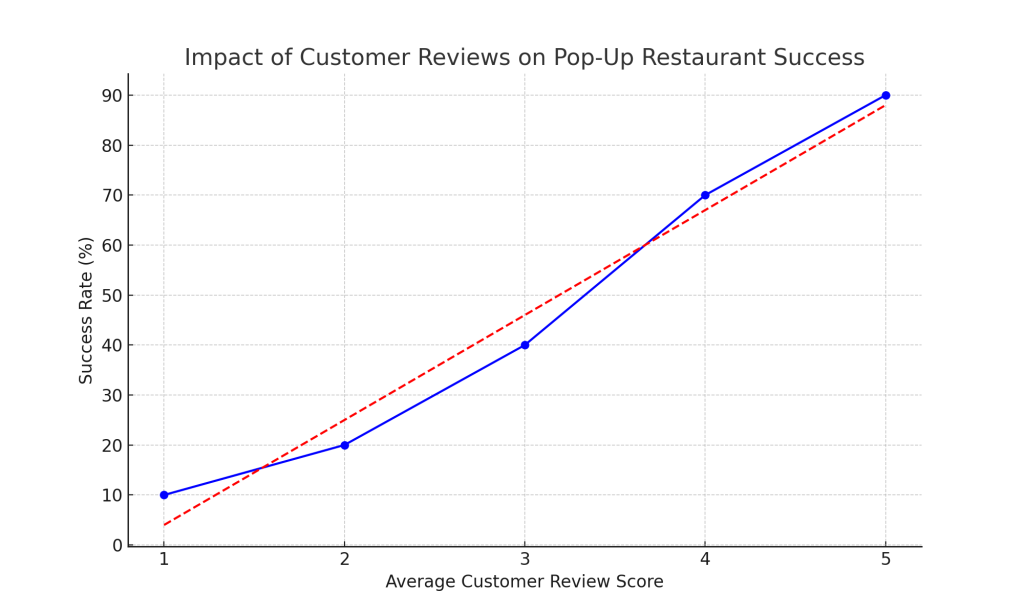Pop-Up Restaurant Risks
Exploring the dynamic world of Pop-Up Restaurant Risks, we find that in recent years, the concept of pop-up restaurants has gained significant traction in the culinary world. These temporary dining establishments, ranging from impromptu eateries in unique locations to exclusive, reservation-only events, have captivated the public’s imagination.

Their appeal lies in their novelty, the opportunity for chefs to experiment with creative concepts, and the sense of urgency they create among diners eager to experience something new and fleeting.
Pop-up restaurants offer a platform for culinary professionals to test new ideas, menus, and concepts without the long-term commitment or investment associated with traditional brick-and-mortar establishments.
Pop-Up vs. Traditional Restaurants: A Contrast of Challenges
While pop-up restaurants share some commonalities with their traditional counterparts, they also face a unique set of challenges and risks:
- Location and Duration: Unlike fixed-location restaurants, pop-ups are transient. They might operate out of different venues, including outdoor spaces, unused retail locations, or even inside existing restaurants. This mobility can be both a benefit and a risk, as it necessitates constant adaptation to new environments and local regulations.
- Financial Uncertainty: Pop-ups often operate on tight budgets with uncertain revenue streams. They might not have the same customer base as established restaurants and often rely heavily on social media and word-of-mouth for promotion. This uncertainty makes financial planning and budgeting a complex and risky endeavor.
- Regulatory Compliance: Navigating the legal landscape is another significant challenge. Pop-up restaurateurs must understand and comply with the health and safety regulations, permits, and licenses specific to each location they operate in, which can vary widely.
- Operational Instability: The temporary nature of pop-ups can lead to challenges in sourcing ingredients, managing inventory, and maintaining quality control. Consistency in food and service quality can be harder to achieve when operating in a non-permanent setting.
- Marketing and Reputation Management: Building a brand for a transient business is challenging. Pop-up restaurants need to create a buzz and attract customers in a short period, and they rely heavily on social media and digital marketing. Any negative experiences can quickly impact their reputation, more so than for traditional restaurants, due to the limited time frame in which they operate.
- Strategic Planning: Long-term planning is inherently difficult for pop-ups. While they provide an opportunity for experimentation, they also require a balance between innovation and practicality. Pop-up operators must be adept at quickly analyzing market trends and consumer preferences.
Financial Risks
- Initial Investment and Budgeting: The table highlights various cost factors that a pop-up restaurant entrepreneur must consider. These include venue rental, permits, equipment, initial food and beverage inventory, marketing, staff wages, insurance, and miscellaneous expenses. Efficient budgeting is crucial to accommodate these costs, especially given the temporary nature of pop-up restaurants.
Expense Category Estimated Cost ($) Venue Rental 2,000 Permits and Licenses 500 Equipment and Supplies 1,500 Initial Inventory (Food and Beverage) 1,000 Marketing and Promotion 800 Staff Wages (Initial Period) 1,200 Insurance 600 Miscellaneous 400 - Uncertain Revenue Streams: Unlike traditional restaurants with a more predictable customer base, pop-up restaurants often face uncertainty in revenue. This unpredictability stems from factors like fluctuating customer interest, varying locations, and the limited duration of the pop-up’s operation.
- Insurance and Liability Costs: Insurance is a significant expense for pop-up restaurants, as it covers various risks, including property damage, liability claims, and worker’s compensation. Ensuring adequate coverage is essential, yet it adds to the financial burden, especially for short-term operations.
Managing these financial risks requires careful planning, a clear understanding of the cost structure, and strategies to maximize revenue while minimizing unnecessary expenses. Pop-up restaurant entrepreneurs must also be prepared for the inherent unpredictability of this business model and plan accordingly.
Legal and Compliance Risks in Pop-Up Restaurants
Pop-up restaurants, while offering a unique dining experience, must navigate a complex web of legal and compliance risks. These risks can significantly impact the operation and success of these temporary establishments.
Navigating Local Regulations and Permits
Pop-up restaurants must adhere to a range of local regulations that can vary significantly from one location to another. This can include:
- Zoning Laws: Understanding where a pop-up can legally operate is crucial. Some areas may be zoned for commercial use, while others are not.
- Food Service Permits: These are essential for any food service establishment, including pop-ups. The requirements for these permits can vary, often involving inspections and adherence to local food safety standards.
- Liquor Licenses: If a pop-up intends to serve alcohol, obtaining a liquor license is mandatory. This process can be lengthy and complex, depending on the locality.
- Temporary Use Permits: In some cases, pop-ups might need temporary use permits, especially if they are set up in unconventional spaces like parks or vacant lots.
Health and Safety Compliance
Pop-up restaurants must ensure they meet health and safety standards to protect both their customers and staff. This includes:
- Food Safety: Compliance with food handling and storage regulations is critical. This can involve temperature controls, proper cooking techniques, and preventing cross-contamination.
- Sanitation: Regular health inspections may be required to ensure the pop-up maintains a clean and sanitary environment.
- Emergency Preparedness: Adequate safety measures, including fire safety equipment and evacuation plans, should be in place.
Employment Laws for Temporary Staff
The transient nature of pop-up restaurants often means employing staff on a temporary basis. This aspect brings its own set of legal considerations:
- Contractual Agreements: Clear contracts outlining the terms of employment, duration, and responsibilities are essential.
- Wages and Hours: Compliance with minimum wage laws and regulations concerning working hours and overtime is critical.
- Worker’s Rights: Temporary staff are entitled to the same rights as permanent employees in many jurisdictions, including non-discrimination and a safe working environment.
- Benefits and Taxes: Understanding the implications of taxes and, where applicable, benefits for temporary employees is vital.
Operational Risks in Pop-Up Restaurants
The success of a pop-up restaurant hinges significantly on its operational efficiency. However, this business model faces several unique operational risks, from location selection to supply chain management.
Location and Logistics Challenges
- Selecting the Right Venue: The choice of location is critical for attracting the right audience and ensuring accessibility. However, securing desirable locations can be competitive and costly.
- Logistics of Set-Up and Tear-Down: The temporary nature of pop-ups means they must be set up and dismantled quickly. This requires efficient logistics planning and can be particularly challenging in unconventional locations.
- Utilities and Infrastructure: Ensuring the availability of essential utilities like water, electricity, and internet in temporary spaces can be a logistical hurdle.
Supply Chain and Inventory Management
- Vendor Reliability: Pop-ups rely on suppliers for ingredients and equipment. Fluctuations in supply, delays, or issues with vendor reliability can disrupt operations.
- Inventory Control: Efficiently managing inventory for a short-term operation can be challenging. Overstocking leads to wastage, while understocking can result in lost sales and customer dissatisfaction.
- Flexibility and Adaptability: The ability to quickly adapt to changes in supply or demand is crucial, particularly when dealing with perishable goods.
Quality Control and Consistency
- Maintaining Standards: Consistently delivering high-quality food and service in a changing environment is a key challenge for pop-up restaurants.
- Training Temporary Staff: Often employing temporary staff, pop-ups must ensure they are adequately trained to maintain service standards.
- Customer Experience: The entire customer experience, from ambiance to service, must be managed carefully to ensure it aligns with the pop-up’s brand and concept.
Case Study: A Pop-Up Restaurant’s Operational Hurdle
Background: ‘Bistro on the Go’, a pop-up specializing in farm-to-table cuisine, set up in a bustling downtown area for a month.
Challenge: Midway through its operation, the pop-up faced a supply chain disruption. A key local supplier of fresh produce encountered unexpected shortages, jeopardizing Bistro on the Go’s menu offerings.
Response: The pop-up’s management quickly engaged alternative suppliers and adapted the menu to incorporate available ingredients without compromising on quality. They also communicated transparently with customers about the change, maintaining customer trust.
Outcome: Despite the initial setback, Bistro on the Go successfully navigated the supply chain issue. The flexibility in menu design and effective communication helped in maintaining customer satisfaction. This experience underscored the importance of having contingency plans and maintaining flexibility in operations.
Marketing and Reputation Risks in Pop-Up Restaurants
The success of pop-up restaurants is heavily influenced by their marketing strategies and reputation management. Due to their temporary nature, these establishments face unique challenges in these areas.
Dependence on Social Media and Word-of-Mouth
- Social Media Influence: Pop-up restaurants often rely heavily on social media platforms for marketing. While this can be a cost-effective strategy, it also makes them vulnerable to the volatile nature of online trends and public opinion.
- Word-of-Mouth: Customer recommendations, both online and offline, are crucial for attracting patrons. A single negative review or experience can significantly impact future business, making consistent customer satisfaction imperative.
Building and Maintaining Brand Image
- Brand Consistency: Despite their temporary setup, pop-ups need to establish a strong, consistent brand image. This includes everything from logo and design to the tone of communication and overall customer experience.
- Adaptability vs. Identity: Pop-ups must strike a balance between adapting to new trends and locations while maintaining a core identity that customers can recognize and relate to.
Customer Satisfaction and Feedback Management
- Feedback Importance: Customer feedback, especially in the form of online reviews and social media interactions, is vital. How a pop-up restaurant responds to and manages this feedback can significantly impact its reputation.
- Proactive Engagement: Engaging with customers proactively, addressing their concerns, and showing appreciation for positive feedback helps in building a loyal customer base.
Graph: Impact of Customer Reviews on Pop-Up Restaurant Success

This graph illustrates the hypothetical impact of customer reviews on the success of pop-up restaurants. It shows a positive correlation between customer review scores and the success rate of pop-up restaurants, highlighting the importance of customer satisfaction and proactive reputation management in this unique business model.
Strategic Risks in Pop-Up Restaurants
Pop-up restaurants, with their unique and ephemeral nature, face several strategic risks that can significantly impact their success. Navigating these risks requires careful analysis and planning.
Competitive Landscape Analysis
- Understanding the Market: Pop-up restaurant owners must thoroughly understand their local dining market, including direct competitors, customer demographics, and prevailing dining trends.
- Differentiation: In a crowded market, pop-ups need to distinguish themselves. This could be through unique culinary offerings, exceptional experiences, or innovative themes.
- Monitoring Competitors: Keeping an eye on what other pop-ups and traditional restaurants are doing helps in staying competitive and relevant.
Short-term versus Long-term Planning
- Balancing Objectives: Pop-up restaurants must balance the need for immediate success (vital for covering initial costs) with longer-term goals (like brand building or testing concepts for a permanent establishment).
- Flexibility in Planning: The ability to adapt plans based on immediate feedback and performance is crucial, but so is adhering to a broader strategic vision.
- Exit Strategy: For many pop-ups, part of the strategic planning includes an exit strategy, whether it is transitioning to a permanent location or ending operations after achieving specific objectives.
Adapting to Market Trends and Consumer Preferences
- Trend Responsiveness: Pop-up restaurants need to be highly responsive to culinary and experiential trends to attract customers.
- Customer Feedback: Regularly gathering and analyzing customer feedback helps in understanding changing preferences and improving offerings.
- Innovation: Continual innovation, whether in menu design, service style, or overall concept, is necessary to keep the pop-up restaurant appealing to a diverse and evolving customer base.
Risk Mitigation Strategies for Pop-Up Restaurants
Effective risk mitigation is essential for the success of a pop-up restaurant. These strategies can help navigate the challenges unique to this business model.
Financial Planning and Budget Management
- Realistic Budgeting: Create a detailed budget that includes all potential expenses, from initial setup costs to daily operational expenses.
- Revenue Forecasting: Develop realistic revenue forecasts based on market research and potentially conservative estimates.
- Cash Flow Management: Keep a close eye on cash flow, factoring in the time lag between expenses and income.
- Emergency Fund: Maintain a contingency fund to handle unexpected costs or revenue shortfalls.
Legal Compliance and Insurance Solutions
- Understanding Local Regulations: Stay informed about local laws related to food safety, business operations, and employment.
- Permits and Licenses: Ensure all necessary permits and licenses are obtained well in advance of opening.
- Insurance Coverage: Invest in comprehensive insurance coverage, including liability, property, commercial auto, liquor, and worker’s compensation insurance.
- Legal Consultation: Consider consulting with a legal expert specializing in restaurant operations to navigate complex regulatory environments.
Operational Efficiency and Quality Assurance
- Streamlined Operations: Develop efficient operational procedures, from food preparation to customer service.
- Quality Control: Implement strict quality control measures to ensure consistent product and service delivery.
- Training Staff: Provide thorough training to staff, emphasizing both operational efficiency and quality service.
- Supplier Relationships: Establish reliable supply chains and maintain good relationships with suppliers.
Effective Marketing and Reputation Management
- Targeted Marketing Strategy: Develop a marketing strategy that targets the right audience through the appropriate channels.
- Online Presence: Maintain a strong online presence, particularly on social media, to engage with customers and build a following.
- Customer Feedback: Actively manage and respond to customer feedback, both positive and negative.
- Brand Consistency: Ensure consistent branding and messaging across all platforms and customer touchpoints.
Strategic Planning and Market Analysis
- Market Research: Conduct thorough market research to understand customer preferences, competition, and market trends.
- Adaptability: Be prepared to adapt the business model based on customer feedback and market shifts.
- Long-term Vision: While focusing on immediate operational success, also keep in mind the long-term goals and how the pop-up can evolve.
- Exit Strategy: Have a clear exit strategy in place, whether it’s transitioning to a permanent location or concluding operations after achieving specific goals.
Conclusion: Navigating the Risks and Embracing the Potential of Pop-Up Restaurants
The world of pop-up restaurants is as exciting as it is challenging. These ephemeral dining experiences offer a canvas for culinary creativity and innovation but come with their own set of risks. Understanding and mitigating these risks is key to harnessing the full potential of this dynamic business model.
Summary of Key Risks and Mitigation Strategies
- Financial Risks: The uncertain nature of revenue and high initial costs can be mitigated through careful budgeting, cash flow management, and realistic revenue forecasting.
- Legal and Compliance Risks: Navigating the maze of local regulations, permits, and insurance needs requires diligent research and possibly legal consultation.
- Operational Risks: Challenges related to location, supply chain, and quality control necessitate streamlined operations, rigorous training, and solid supplier relationships.
- Marketing and Reputation Risks: The dependence on social media and word-of-mouth for marketing can be managed through targeted strategies and proactive customer engagement.
- Strategic Risks: Understanding the competitive landscape and staying adaptable to market trends is essential for long-term planning and sustainability.
The Future Outlook for Pop-Up Restaurants
The future of pop-up restaurants looks promising. As consumers continue to seek unique dining experiences and culinary innovation, the demand for these temporary ventures is likely to grow. Additionally, the flexibility and lower overhead costs of pop-up restaurants make them an attractive model in an ever-changing economic landscape.
Final Thoughts: Balancing Creativity and Caution
The essence of pop-up restaurants lies in their ability to offer something new and exciting. This creativity, however, needs to be balanced with caution. Success in this space requires more than just culinary talent; it demands an equal measure of business acumen, strategic planning, and risk management. Pop-up restaurant entrepreneurs must be prepared to adapt quickly, anticipate challenges, and respond proactively to the ever-evolving dining landscape.
In conclusion, while the journey of running a pop-up restaurant is fraught with risks, the rewards for those who navigate these challenges successfully can be significant, both in terms of financial success and creative fulfillment. As the dining world continues to evolve, pop-up restaurants will undoubtedly play a pivotal role in shaping its future.
Relevant articles:

